University Educators @ Kentucky Museum
Each semester, WKU faculty utilize the collections and exhibits at the Museum with their classes. Questions? Contact Education Curator Dr. Christy Spurlock.
These courses listed by college are just a few examples of the many ways university educators are utilizing the Museum as a teaching resource.
College of Education and Behavioral Sciences
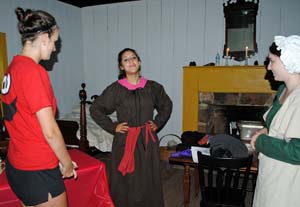
Elizabeth Riggs
The Kentucky Museum often presents an overview of all of our K-12 tours, programs and resources for various preservice teachers, as well as current teachers seeking their Masters degrees in education. Specifics and focus varies by semester and request of professor.
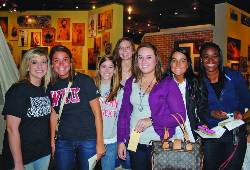
Dr. Judy Pierce
Each semester, ELED 407 students tour the Museum with the Education Curator and develop exhibit based scavenger hunts appropriate for elementary aged students. Students also receive training in a variety of educational resources available from both the Department of Library Special Collections & the Museum for student teacher use. Resources include traveling trunks, KenCat and primary and secondary sources.
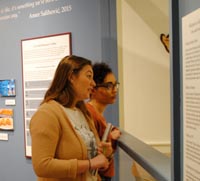
Robert E. Wilson
During a self-guided tour of the museum, students choose an object related to leadership. Students write a paper about the object and its use in leadership.
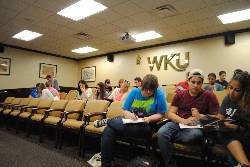
Several instructors bring their University Experience classes to the Kentucky Museum. Some classes come for self-guided or docent guided tours, while others opt for Museum faculty led tours. Instructors often use the opportunity to introduce students to the various collections and holdings of both the Museum and the Department of Library Special Collections. It is hoped that with an early introduction to the KY Buildings holdings, students may use materials in their future research endeavors.
College of Health and Human Services
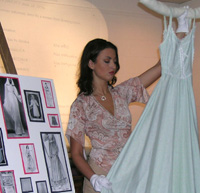
Carrie Cox
In this modern adaptations project, students photograph garments from 1950s - 1970s to find elements or details in contemporary clothing.
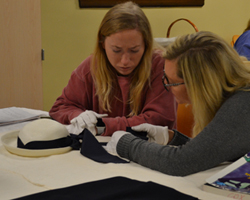
Carrie Cox
Garments and accessories are chosen by Sandy Staebell for students to research as part of a garment documentation project. Students conduct technical research by measuring the artifacts, documenting their construction and photographing the items. Students also conduct in depth research on the history and provenance of each item. Their findings culminate with a presentation and research portfolio on the garment and accessory they were assigned.
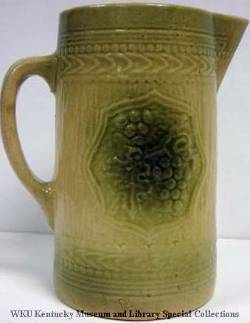
Jack LeSieur
For a midterm project, our class first met at the Kentucky Museum to learn about resources available to them from both the Museum and the Department of Library Special Collections. Subsequently, students selected a specific decorative arts object at the Museum with the guidance of the collections curator, Sandy Staebell. Students then were able to research their objects with the help of the collections curator and the DLSC librarians. The goal of this project was to demonstrate to students the vast array of resources available at both the Museum and the DLSC, as well as provide insight into the range of topics, people, and tasks involved with recreating historic interiors.
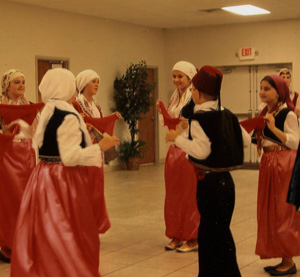
Eric Knackmuhs
Students toured the A Culture Carried: Bosnians in Bowling Green exhibit then completed an assignment which investigated and reflected upon the role recreation played in relocating and restarting life in the US.
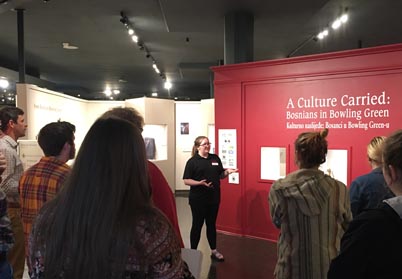
Eric Knackmuhs
Students took a guided tour of A Culture Carried: Bosnians in Bowling Green then evaluated the tour in order to learn how to conduct their own talks and tours later in the semester.
Gordon Ford Business College
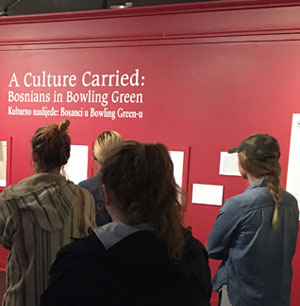
Dr. Dana Cosby
Students studying international business and culture to understand how the economic, political, cultural, and social parts interact toured A Culture Carried: Bosnians in Bowling Green exhibit and wrote a reflection paper on why it is important to understand how those elements impact international business locally.
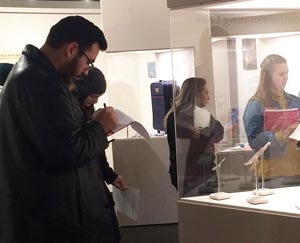
Dr. Dana Cosby
Students toured A Culture Carried: Bosnians in Bowling Green exhibit and after an open discussion they completed a reflection paper connecting what they experience with international management implications.
Ogden College of Science and Engineering
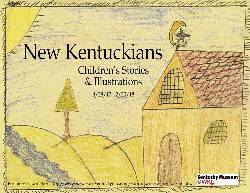
Erin Greunke
Geography students studied European movement of people as it relates to Bowling Green, KY. Bowling Green has a large immigrant population, due in part to Bowling Green being home to the International Center of Kentucky (ICOFKY). Students were tasked with selecting a piece of artwork within the New Kentuckians exhibit, and to write about the artwork within the context of the immigration/refugee movement. Final work was included in the Geography 110 Facebook page.
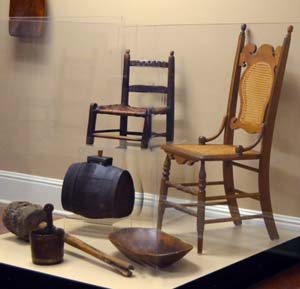
Amy Nemon
Students did a self-guided tour of The Essential Tree and Salient Features exhibits.
Potter College of Arts and Letters
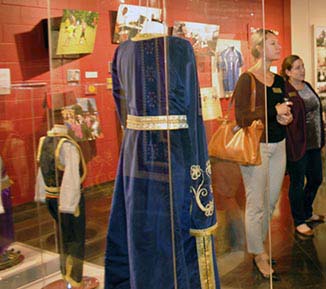
Dr. Ashley Stinnett
Folklife Specialist Virginia Siegel provided an introduction to the exhibit, A Culture Carried: Bosnians in Bowing Green. Students toured exhibit, taking notes relevant to class content. Based on their course readings on ethnicity and nationalism, students responded to the following writing prompt:
Define ethnicity in your own words then explain, in general terms, how the concept of ethnicity has been used by groups of people for a particular purpose. What was your general impression of the information presented at the museum, and why? What was the most impactful aspect of the exhibit for you? What did you learn from the exhibit about Bosnian refugees? How have Bosnian refugees in BGKY experienced their ethnicity?
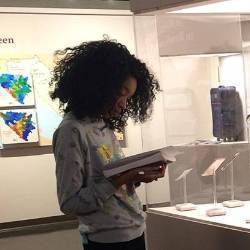
Dr. Kate Horigan
After touring and studying the exhibit, students were asked to reflect upon A Culture Carried: Bosnians in Bowling Green. Exhibit reflection prompt was divided into three parts.
1) How are interviewees’ words shared and framed in this exhibit? Describe your encounter with these words as a visitor to the exhibit (for example, what was your reaction, how did you interpret them, what questions do you still have?). 2) Describe one object, story, or custom from the exhibit that you found especially expressive of Bosnian or Bosnian-American culture. What did this object/story/custom communicate to you about people, and how did it do so? 3) Describe anything else that you noticed or that surprised you.
One student reflected, "I felt a range of emotions—sadness at what they’ve gone through and continue to go through, admiration for their strength and adaptability, and amazement at their intricate culture.”
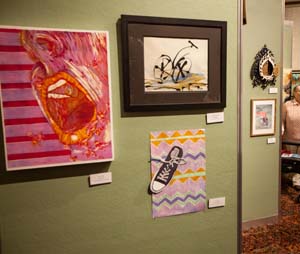
Brent Oglesbee and Sam Hunt
Students use art exhibits to identify elements of art and principles of design within a work of art.
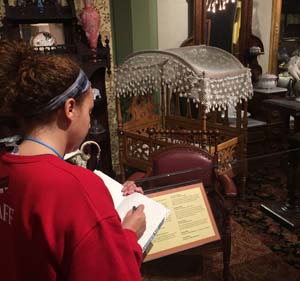
Leslie Nichols and Mike Nichols
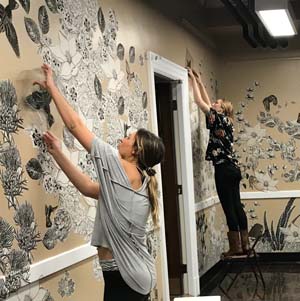
Marilee Salvator
Printmaking classes use the museum for multiple programs. Students visited the POW exhibit researching the prints and printmaking processes and then used it as an inspiration for their final project. Printmaking classes also used the Museum's Community Gallery as a backdrop for their Flora and Fauna installation.
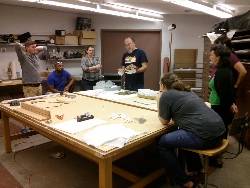
Kristina Arnold
The Corridor Gallery exhibition in FAC illustrates a partnership between PCAL, the Kentucky Museum, the University Libraries, and the extended Bowling Green community. Students in the course chose exhibit topics after conducting research on the collections held by the Kentucky Museum and the Department of Library Special Collections. They selected and borrowed specific objects from the Museum and Library with which to develop their exhibit themes, and researched and wrote label copy interpreting each piece's significance. In many cases, student curators conducted outside interviews with community experts as part of their research process. All worked with Kentucky Museum exhibits staff to create mounts and safely install their objects.
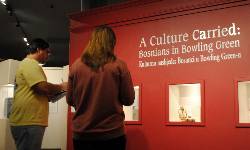
Dr. Judy Pierce
Each semester, ELED 407 students tour the Museum with the Education Curator and develop exhibit based scavenger hunts appropriate for elementary aged students. Students also receive training in a variety of educational resources available from both the Department of Library Special Collections & the Museum for student teacher use. Resources include traveling trunks, KenCat and various other primary and secondary sources.
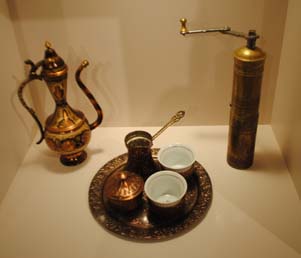
Dr. Tim Evans
Virginia Siegel, Folklife Specialist, Kentucky Folklife Program lead a tour of A Cultural Carried: Bosnians in Bowling Green exhibit. Students reflected on the tour in written form and during class discussions.
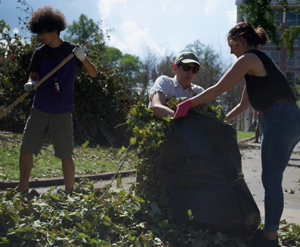
Students assist construction of Stickworks project as well as documentation the process and develop a companion website about the Stickworks construction for the Museum
https://www.kymuseumstickwork.com/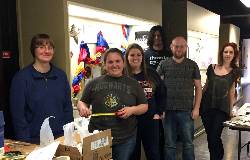
Dr. Michael Ann Williams
In spring of 2017 students enrolled in FLK/ANTH 470 and FLK 470G created the small exhibit, “Korea Through Kentucky Eyes”, as part of the International Year of South Korea. Graduate students, and some undergraduates, researched and developed themes, identified objects and pictorial materials, wrote label copy, designed the overall look of the exhibit, and physically constructed it. In an intensive two and half months, students engaged in the creation of an exhibit from beginning to end. The students also sponsored an opening reception which included a narrative stage which featured a dialog between two Korean Americans living in Kentucky (one a student and the other a faculty member).
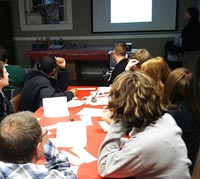
Dr. Ann Ferrell
Students were introduced to Museum's and Library's Special Collections in preparation for writing a research paper based on primary materials.
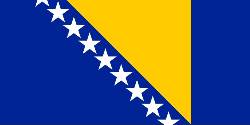
Dr. Tim Evans
Students in FLK 562 worked with the Museum education curator and the local Montessori school to design a Bosnian Culture Traveling Trunk for grades K-6. The trunk features an extensive lesson plan with numerous activities and handouts, connections to Kentucky state standards in Social Studies, Geography, Arts/Media Arts, Music Science, Mathematics, and Practical Living. It includes units on Bosnian history, the refugee experience, home and family life (including food traditions, herbs and embroidery), and recreation (including soccer, music and dance). The Bosnian Traveling Trunk was funded by the following: WKU International Year of Program, WKU Department of Folk Studies and Anthropology and WKU Potter College. For more information about the contents of the Bosnian Cultural Trunk, or to checkout and use the trunk, visit the Museum's Traveling Trunk web page.
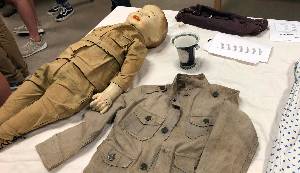
Multiple Instructors: Selena Doss, Greg Marshall, Kate Brown, Tony Harkins
Curators and librarians filled the Museum's classroom with WWI/II artifacts, doucments, posters, uniforms, diaries, letters and more for special Close Study of Collections sessions. Students were able to examine items up close and professors assigned a variety of assignments in conjuction with the sessions.
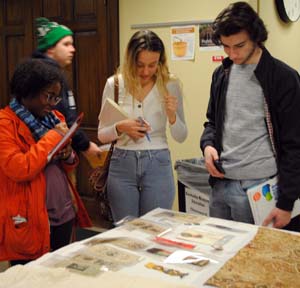
Jen Hanley
US Since 1865 history class utilized the Echoes of the American Revolution - A closed classroom study of Kentucky Building sources that reflect the enduring legacy of the American Revolution.
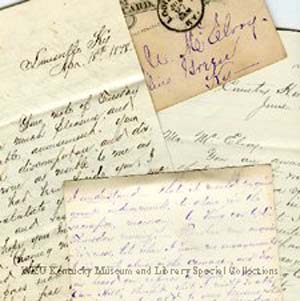
Selena Doss
Students studied artifacts and documents relating directly to enslaved people such as bills of sale and photographs. Students also studied paintings and advertisements to see how slavery was depicted in the 20th Century.
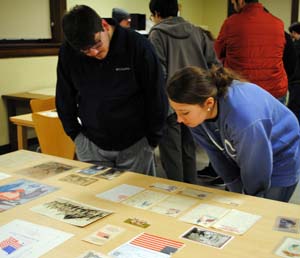
Kate Brown
American Revolution/Early Republic history class utilized the Echoes of the American Revolution - A closed classroom study of Kentucky Building sources that reflect the enduring legacy of the American Revolution.
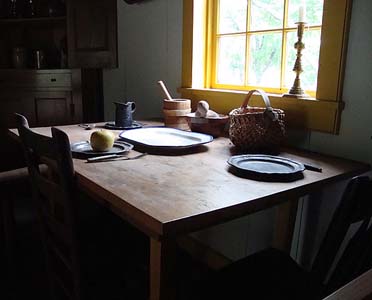
Carol Crowe Carrico
Students toured the 1815 Felts Log House.
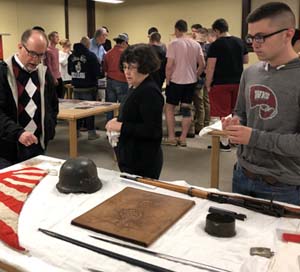
David Serafini
Curators and librarians filled the Museum's classroom with WWI/II artifacts, doucments, posters, uniforms, diaries, letters and more for a special Close Study of Collections session.
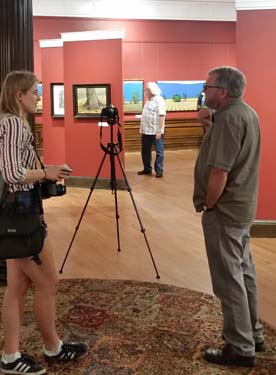
Shura Pollatsek
Students in Design II did an analysis of visual design for scenic and lights of Stickworks and Salient Features exhibits.
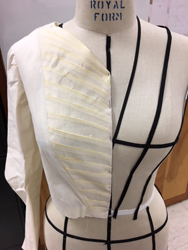
Shura Pollatsek/ Lindsey Eastman
Special Problems in Tech Theatre: Adv. Costume Technology
The course is a study in how to make patterns for garments through a method called draping. The class’s final project is to make a pattern for a historical garment. In preparation for this, they first visit the Kentucky Museum as a group to view historical garments in the collection and learn how to examine them for details of construction and shape. Then, each student chooses an era and type of garment they plan to make, and they each set up an individual meeting with the curator to study items related to their chosen project in detail. The students assemble a portfolio of historical research, both from the museum and other sources, and use the information to make a “mock-up”, or rough draft version of the historical garment.
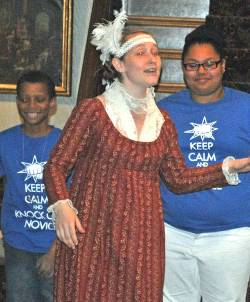
Carol Jordan & Christy Spurlock
The museum theatre practicum is an hands-on independent project developed in combination with the WKU Theatre and Dance Department and the Kentucky Museum. Students are required to choose and research some aspect of the Kentucky Museum’s collection. Students develop a short performance piece based on their research. Working with both departments, the student refines the script and the performance, ultimately performing the museum theatre piece they have created for multiple audiences.
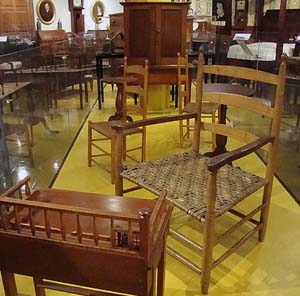
Dr. Bella Mukonyora
Students toured Decorative Arts exhibit focusing on the Shaker artifacts.
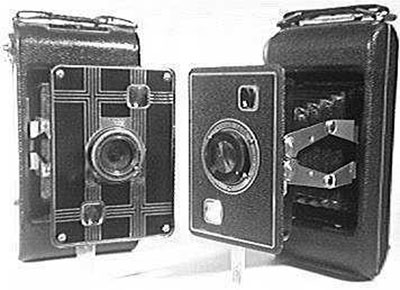
James Kenney
Students research photography and the photographic process using Museum's camera collection and Library Special Collection photograph collection to prepare a timeline of photographic history.
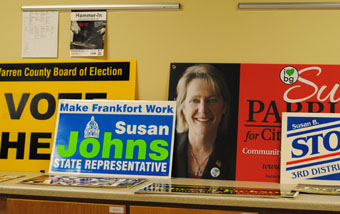
Victoria Gordon
Students research and write biographies of female politicians from the Rather Westerman Collection. Their work facilitated an exhibit on politics in Kentucky.
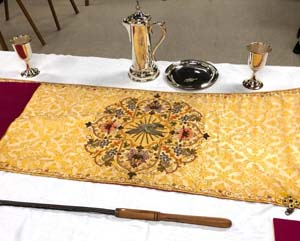
Dr. Bella Mukonyora
Students begin the semester studying artifacts and material culture of mainstream historic churches in Bowling Green.

